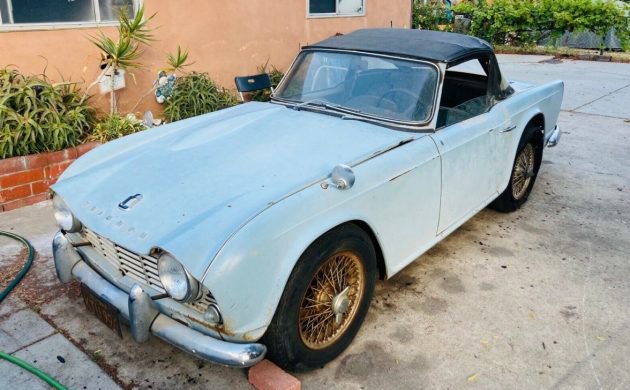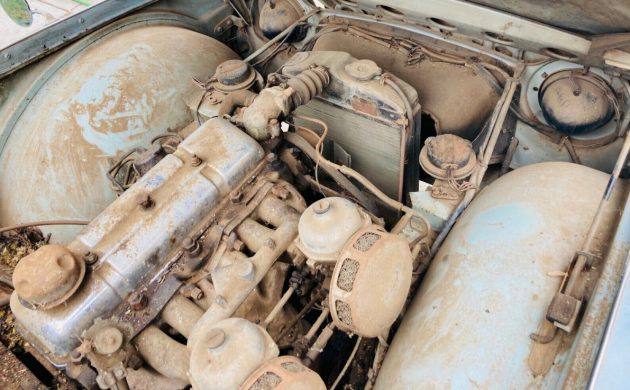A few years before one-time tractor mechanic Ferruccio Lamborghini produced his 350 GT, Italian design met farm machinery in the form of another sports car: a little English roadster called the TR4. This example is located in Chula Vista, California, and is listed here on eBay. At the time of writing, the high bid is just under $4,000 with four days left in the auction.
Following the success of the TR3, Triumph looked to Giovanni Michelotti for the design of their next sports car. By this time, Michelotti had done work for the most famous names in the world of Italian motoring, including Ferrari, Alfa Romeo, and Maserati, and had just completed the design for Triumph’s own Herald saloon. The new car would be a radical departure from the spartan TR3, with windows that rolled down into the door, synchro on all four gears, and an optional pre-Targa targa top– a design element it shared with another Michelotti creation, the Fiat 1200 “Wonderful” by Vignale. Under the hood, though, it had the same engine: an inline-4 originally developed for the Ferguson TE20 tractor. For the TR4, however, the displacement was increased to just under 2.2 liters, bringing horsepower up to a blistering 100 bhp and pushing the car from zero to sixty in just under 11 seconds before topping out at well over a 100 miles per hour. It should be noted that this was without the optional supercharger, which doubled the horsepower and allowed the car to get more out of its little engine at low RPMs.
This 1964 model predates the move in 1965 to the TR4A, which boasted independent rear suspension among other upgrades. The “O” on the Commission Number plate means this car was originally equipped with overdrive: a desirable feature for this model. From the pictures, the rust does not seem to be too bad, though pictures can be deceptive and any buyer would be well-served to have a good look under the car. Evidence of rodent infestation abounds: aside from a thorough cleaning and necessary work on the interior, this means that the electrical systems will need careful attention (though, this being a British sports car, that really goes without saying).
Despite its relatively low production numbers compared to the TR3 or the later TR6, the TR4 is mechanically simple and if the body panels are straight, restoration should be relatively straightforward. Triumphs boast a devoted fan-base with a number of local clubs, so support and advice shouldn’t be too far away, and aftermarket parts are available through suppliers like Moss Motors. A sprightly little car like this could be an excellent first project, or a rewarding experience for the more seasoned devotee. It’s not hard to imagine this car rolling away from the church back in 1968, seeing two young people off on the start of their journey together. Since then, there’ve been lot of stories, a lot of miles under those wheels– with a little work, this car will doubtless be there for more great moments on the long road ahead.




Oy,,,well, you want a “4 to restore”, it won’t get much better, even though, @ $1,500,unless that, like the year was a mistake( they claim a ’63 now) and 0 bids, the ad was removed. This should be a stark reminder where we are today. The steam has all but gone out of restoring a British roadster, even though, parts today are easier to get than ever. Kind of a conundrum, parts galore( for a hefty price, I might add) and fewer and fewer people want a car like this. Clearly, nobody in the family wants it, a sad reminder of where we are today. TR4’s are my favorite Triumph, one, a ’67 “A” IRS , BRG, those mini-lite mags,and impeccable, was in the park in my town. I gazed upon it’s beauty for like 5 minutes waiting for the owner to return, but I’m a busy man, had to go, but it was a beautiful car.
It always amazes me that, when folks are trying to sell a restorable collector car, they don’t bother to clean up the engine compartment or a least wipe the dust off of the exterior. It would be a good idea to at least vacuum the rodent poop out of the interior, before taking photos. That alone, would bring in more bids.
I’ve seen a lot worse TR4s for four grand. It appears to be a California car. So rust is probably a minimal issue. TR4s restored as drivers are a hoot to drive and you could get as much attention as if you were driving a Ferrari.
As for, “No body in the family wants it.” that could be because it has that theft proof system. That’s three pedals and a manual transmission. Ha! Ha!
Hi Danny, maybe I can field this one. Generally, as in this case, the vehicle is a hassle for someone,get rid of it. You know “dad” would have cleaned it up, or even let it get like this in the 1st place. This is where the deals are, sadly, and I agree, a great start for someone. Restoring one isn’t like restoring a 1960 Imperial( or whatever), they are extremely simple cars and fixing them is part of the fun, at the side of the interstate, not so much, but proper tuning can make these as dependable as any.They cruise at 55-60, again, an O/D would help, but required. These are for back road touring, and speed was not an issue. “Theft proof”,, Ha! While there is some merit to that, there are still a lot of stick shift cars out there. Of the dozens of Jeeps I looked at, maybe 1 was an automatic.
The ’62’ had a white dash facia, maybe the ’63’ I’m not sure, but ’64’s did not. I have a ’64’ currently, and the dash is not white.
I have said it before, that I abused my ’62’ back when I was in college in ’71’ ,and it came back running strong every day. The TR4 was and is a good buy for restore and enjoy…
The first car that I travelled in over 100mph was a TR4A in the outback of Western Australia in 1969… I remember the electrically actuated overdrive was engaged with a lever similar to the indicator but on the opposite side of the steering colum.